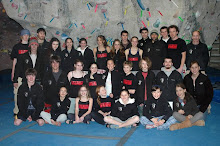Beyond the Caption
He has photographed and climbed with the best climbers in the world at just about every desired climbing location in the world. From the rickety wooden walls of the Dover climbing gym that he built, to the towering faces of Cathedral and Whitehorse, all the way to the forefront of climbing media, he has seen and learned a lot about our sport.
The first time I met him years ago was at Rumney. He seemed calm, controlled, and calculated. Words were only spoken when necessary and the occasional smile was about as frequent as me sending V14. Later, I would learn that his seemingly serious facade was mostly false due to his intermittently infectious humor. He's tricky.
Much later that day he called me for a 2AM, Dover session (Yes, two o'clock in the morning). I arrived at the designated hole-in-the wall gym to find him and Justin Bourque, a 6-foot-3 brick house, throwing disgustingly massive moves off terrible pinches on a 45-degree plywood wall.
I was intimidated.
One light flickered in the back of the cave and 50 cent blasted from surround sound speakers. This was going to be a training session from hell.
"What took you so long man?" asked Tim with his usual dead-seriousness.
We started climbing and his energy propelled the three of us to start pulling harder than ever.
"Get psyched! GGGGGETTT PSSSSSSYCHEDDDDD!" he shouted in one of my ears while my faced turned purple as I pulled on some stupid-hard pinch problem, which I later learned to be the classic, Dover climbing style. Powerful. Big. And dynamic.
We climbed hard, exhausting ourselves deep into the cold night that lingered outside the thin, gym walls just waiting to attack us upon exit. That was the night I learned what it meant to try hard. Really, really hard.
Six hours later, the morning after the morning session, I found Tim roping up at Cathedral to send some new, sketchy death pitch. Motivation and commitment at its finest.
Today, he is a climbing media juggernaut, maintaining an extensive influence on the flow of climbing advertisements, photography, film, and general marketing direction. What's more, is that he continues to crush. In fact, the day he shot me at Pawtuckaway for some footage of a few classics, he asked me to hop on Blow (V10) for a quick warm-up. You serious broski? The problem consists of one dyno from two, credit card thin crimps to a jug.
"You got that wired? Do it," Tim suggested as if it would be like walking up a flight of stairs.
"Um. No. Not at all."
Moments later, Tim asked me for my shoes and without a word or warm-up, he floated the dyno. He had tried it a bit earlier that week, but come on. That's gross.
(Side note: If you want to refine your technique, or more specifically learn to use your feet, climb with Tim for three minutes. Done.)
In either case, many of you only know him through photo captions or horror stories about some X-rated pitch up in Northern New Hampshire. Here is chance to take a closer look inside the head of a guy who has made it to the avant-garde of climbing media with cutting edge photography and a futuristic, progressive-type vision. Amen and Go Pats.
The Insider
When and where did you start to realize that climbing was going to be a major part of your life, if not all of it?
The biggest turning point was in High School when I quite baseball. I kicked ass at it and could have got a scholarship to go to college with it, but it was taking away from my climbing time. Even today, a bit more mature, I struggle doing anything less than %100. Back then, it was all or nothing for sure.
Even though you have been all over the world, would you say you still have a strong, nostalgic connection to where it all started? Why?
Three words: October in New England.
New England has the rock; its got the scene, but it seems like everything else (largely the weather, bugs, and leaves) are at there best in October.
Did you always want to be a professional photographer, or did your passion for climbing and creative ideas for marketing the sport sort of evolve together?
It’s definitely evolved over time. I used to have troubles with people calling me a pro photographer. I was like “No, I’m a climber that takes pictures”. As the photography grew, I wanted to help my friends (the pro climbers) the best I could and a desire to see the industry evolve stemmed from that.
With years of perspective and experience under the ole’ belt, what would you pass on to the youngsters of this generation about climbing?
Like any sport, there is always going to be someone stronger than you somewhere in the world. That’s not what you should strive for. So leave your mark by giving back to the sport, returning smiles at the crag, and offering a belay to those that need it. You’ll get further in the sport and in life that way anyhow.
Where would you like the sport of climbing to be in the next 10 years?
The sport itself won’t change much in 10 years. We are seeing diminishing returns training wise to a degree right now. Hopefully, the industry will have evolved to the point where ten-year-old kids can dream about one day making a legitimate living off the sport if they are good enough.
How do you think climbing has changed from when you first started in 1993 to today?
Climbing wise the physical limits of strength are finally maxing out. Pure difficulty is giving way to style of ascent as a more significant statistic, so to speak, in the way climbers view accomplishments.
Industry wise all those companies that started out and saw growth in the 1980's are looking for anyway they can to be considered "cool" again, like they were in 1993.
Do you think it is possible to have a Sean White of climbing? Basically, what is it going to take to have massive, corporate sponsors like Nike or Visa start handing out millions to someone like Mr. Woods?
Two things:
1) Time – As an industry the climbing world is 20 years behind skate and snow sports. So, give it time.
2) Competition – Like it or not, competition is the one thing that climbing has that every human understands. Now if you can deliver competition in an understandable format, and with consequences, like all the other action sports, then you can sell the lifestyle. And if you can sell the lifestyle, then climbing becomes the story you sell mainstream, and mainstream is the checkbook that hands out the millions of dollars.
Check out his work at kemplemedia.com. His website is almost as good as my blog...
Tuesday, January 29, 2008
Subscribe to:
Posts (Atom)







